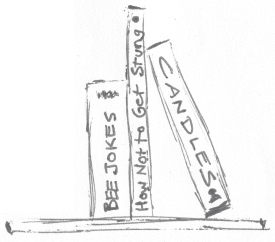FOUR SEASONS OF HONEY
The annual rhythms for beekeeping parallel those of gardening. That makes sense considering the symbiotic relationship of bee to flower. As with anything that you do outside, every season provides different variations and challenges, as well as preparations for what's coming.
Winter: Busy as a Beekeeper
Winter is unusual in that it's the only season when the beekeeper works harder than the bees. While the bees' job is pretty much to survive, the beekeeper has to build, repair, make plans. . . .
For an aspiring beekeeper, winter is the best time to get started. To begin with, there's a certain level of construction necessary to put together a beehive. Some are willing to pay a premium to get everything delivered prebuilt, but for most of us, getting the hive bodies together means buying precut kits of the boxes, frames, and beeswax to assemble and paint. (While it's possible to build hives from scratch using plans and lumber, nobody would even think of it, unless they have a lot of power tools and an inordinate love of woodworking.)
Besides building new hives, there's also maintenance on the old ones. Before winter I took off the one to four “upper stories” of the hive (called “supers,” where bees store the excess honey), leaving the two stories of “hive bodies” (where bees cluster together to keep warm with the brood), and enough pollen and honey to keep the colony alive through the winter.
This pile of empty supers is ripe for inspecting, repainting, repairing, and/or replacing. There are things to watch for: wax worms, for example, the larvae of a moth that somehow manages to find far-flung and remote beehives and lay eggs inside them. An active colony will discover the larvae and eject them, but take the boxes off the active hive and there's nothing to prevent them from chewing up the precious wax combs and leaving a mess.
The winter is also when you need to figure out if you'll need new bees and decide how you're going to get them. There are several choices. Established beekeepers may decide to split a strong hive into two. They may decide to wait until swarm season in early spring, with the hope of catching a few swarms and placing them in their empty hives. For many new beekeepers that sounds daunting. They (or experienced ones who want a specific type of bee) will reserve package bees to be shipped or picked up in the spring. But that is also a winter task. Usually the bees are sold first come, first served. If you don't reserve bees early in the winter, you might not get yours until weeks or even months into the spring, decreasing the chances of getting a significant amount of honey the first year.
Winter is also a good time for reading bee guides, brushing up on beekeeping knowledge and skills, and looking for new ideas or answers to questions you might've had.

There is, of course, no honey. In fact, much of the time, there's no visual evidence that there are any bees in those hives. As with gardeners and their seed catalogs, the catalog from Dadant's Honey Bee Supply Co. serves as a first sign of mid-winter—an encouragement and comfort to the impatient, winterphobic beekeeper.
During any sunny winter “warm spell,” the bees make a brief cameo, taking the opportunity to fly out and purge long-filled digestive systems, returning to the warmth of the hive as quickly as possible. I wonder if I should let them use my iPod during the rainy days ahead. I figure I can load it with the Honeys, the Honeycombs, the Buzzcocks, B. Bumble & the Stingers, the Bee Gees, and the Bird and the Bee. Perhaps even an assortment of B-sides and B movies like Bee Season and The Sting.
Spring
The bees are impatient about the late season rains. You can see them staring wistfully out of the hive entrances like school kids missing recess. A break from the rain gives them a chance to raid the flowers blooming all around us, and the intrepid beekeeper a chance to check out the progress so far. They keep promising that the sweet stuff's coming soon, but he replies, “Show me the honey!”
When we harvest honey, the smell of sweetness and beeswax fills the house. The bees are very busy and the spring honey comes in with wings on. If you've never had fresh unprocessed honey before, it's amazing how many different flavors you can taste in there besides just what you'd identify as the dominant “honey” flavor. It's like the difference between a freshly picked garden veggie and a store-bought one, or a really good wine and a mediocre one. The honey going into jars is light-colored and light-flavored, as bright as the spring flowers it comes from; as the summer and fall progress, the honey will get darker and the flavors will become even more complex.
Summer
The summer honey is flavorful and florid, the color darker, as we move out of the subtle spring flavors into the more robust summer ones.
Autumn
The last few harvests of honey in the fall have a slightly sad feel to them,. Another harvest season, another ending of a productive year. The honey is interesting, though: dark, with a molasses flavor to it and a slight grace note of eucalyptus, tasting a little like a minor key chord, a bit of autumnal melancholy, of golden sunsets, lengthening shadows, and cool autumn nights.